Creating Pathways: SPIRALS Open Archive by PartSuspended – Reflection#1
08th December 2022Barbara Bridger, Georgia Kalogeropoulou, Hari Marini
SPIRALS Open Archive team:
Barbara Bridger, Sarahleigh Castelyn, Noelia Diaz-Vicedo, Georgia Kalogeropoulou, Hari Marini
Contributing artists:
Dimitra Adamopoulou, Ruth Asidi, Niya B, Suparna Banerjee, Sally Pomme Clayton, Colin Cruise, Krishna Goswami, Nikos Kabasele, John London, Lynn Lu, Kostis Ntemos, Simon Persighetti
PartSuspended is an artist collective that uses a range of performance practices to explore the intersection between various aspects of contemporary life. These include personal experience, the everyday, social spaces and architecture. We are particularly interested in feminist work that asks questions and challenges conventional boundaries and forms through artistic creation. Our work connects individual and collective creativities and helps imagine new possibilities for feminist action. It follows an interdisciplinary approach and includes live performance, movement, sound, video-work, writing, participatory workshops, exhibitions and installations. Our performances and workshops are multi-media, multilingual and multidisciplinary.
At the core of the collective’s recent work is the ongoing collaborative and interdisciplinary project SPIRALS (2013-ongoing) [1]. The image of the spiral shapes both the form and content of our creative practice. SPIRALS is a poetic journey that crosses geographical borders and unites women’s voices in an exchange of languages, cultures, personal narratives and modes of expression. The spiral acts as a sign of becoming, transforming and awareness.
SPIRALS interventions have taken place in several countries, including the UK (London, Broadstairs, Coventry, Devon), Spain (Barcelona, Agost), Serbia (Belgrade), Greece (Athens), India (Pune). Recently, in May 2022, PartSuspended ran a series of workshops open to the public [2], and gave an artist talk and a live performance within the AVSchool of the Department of Audio & Visual Arts located at the Ionian University [3]. Earlier, in February 2022, we published a collection of essays under the title ‘On Spirals’ in the European Journal of Women’s Studies [4]. In these essays, we reflected on our processes of working on the SPIRALS project, examining the spiral form as applied to women’s experiences, and making links between our various projects and a range of social, cultural, linguistic and philosophical influences [5].
The collective maintained online contact and made work throughout the Covid-19 pandemic. Repeated lockdowns and the added complications of the UK exiting the European Union, created a difficult environment where regular communication and planning new work was particularly valuable and at the same time vulnerable. The context also had an influence on what we produced, and the isolation we all experienced during the pandemic prompted a strong desire to share our processes, expand our work and ideas, seek out connections with other artists and open up creative dialogues.
We decided to do this by inviting artists to contribute to a SPIRALS Open Archive (SOA). The initial idea was to create a ‘toolbox’ related to our SPIRALS project and offer this to artists and non-artists, in order to inspire and encourage them to create their own spirals and explore their personal space, their city, their desires and to initiate a creative dialogue beyond borders. It was an attempt to unite participants and to establish an international community of ‘spirallists’.
Our aim was to produce an archive that was flexible and open and provided insight into the process and dialogue surrounding the artworks. The idea of a flexible and open archive is in line with our artistic view, as we consider the process of making work more crucial than a ‘finished’ outcome that is frozen in time. We believe in and support a multivocal working environment and we are inspired by ‘unfinishedness’ as this leaves possibilities open and creates a space where changes can happen. In the SOA we wanted to say something about this particular moment in time and establish an archive that can accept a variety of artistic voices and make unexpected connections. At the heart of the SOA lies our desire to create an opportunity for our participants to leave a personal record of some kind, a mark or trace, whilst artistic work can continue to be accumulated, developed and attain different meanings as it finds itself in dialogue with other works.
The first step in opening the process was to invite artists with whom we had some connection. We needed to have a community that would be open to experimentation and would be interested in exchanging ideas and in sharing their practices and personal experiences. We also operate within a feminist perspective and were looking for collaborators who would be sympathetic to this approach.
Following a period of discussion and experimentation within the PartSuspended group, Barbara Bridger, Sarahleigh Castelyn, Noelia Diaz-Vicedo, Georgia Kalogeropoulou and Hari Marini made suggestions for instructions and provocations. We devised a set of prompts and created a video-work based around them. The video-work was edited by Georgia Kalogeropoulou who also created the soundscape. We then collated this material and shared it with all invited artists.
The set of prompts and the accompanying video and soundscape provided participants with evidence of the way we work as a collective. Through sharing images that we had already produced during our ongoing SPIRALS project and blending these with sound and text, the invited artists could get some sense of how we question and challenge conventional boundaries and forms.
We devised three headings for our prompts. The first was ‘Time, Memory, Home’, the second ‘Space, City, Ecology’ and the third ‘Self, Desire, Dreams’.
In the section ‘SPIRALS – TIME, MEMORY, HOME’ artists had the chance to explore their memories and share their deeper thoughts in relation to their lives, childhood, choices and connections.
The section ‘SPIRALS – SPACE, CITY, ECOLOGY’ encouraged participants to find a way to embody the place where they live, and become inspired by their city, neighbourhood and/or landscape.
The final section ‘SPIRALS – SELF, DESIRE, DREAMS’ allowed personal exploration and the sharing of desires and dreams.
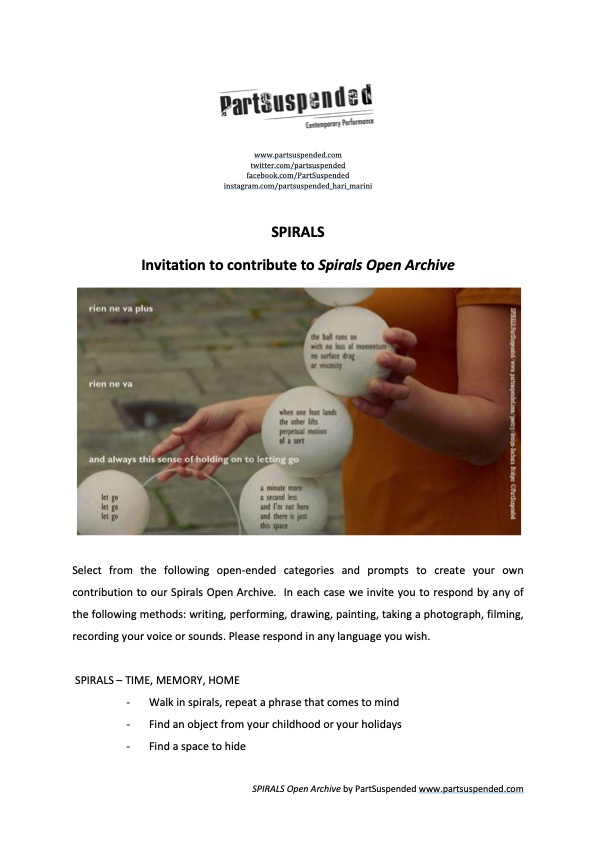
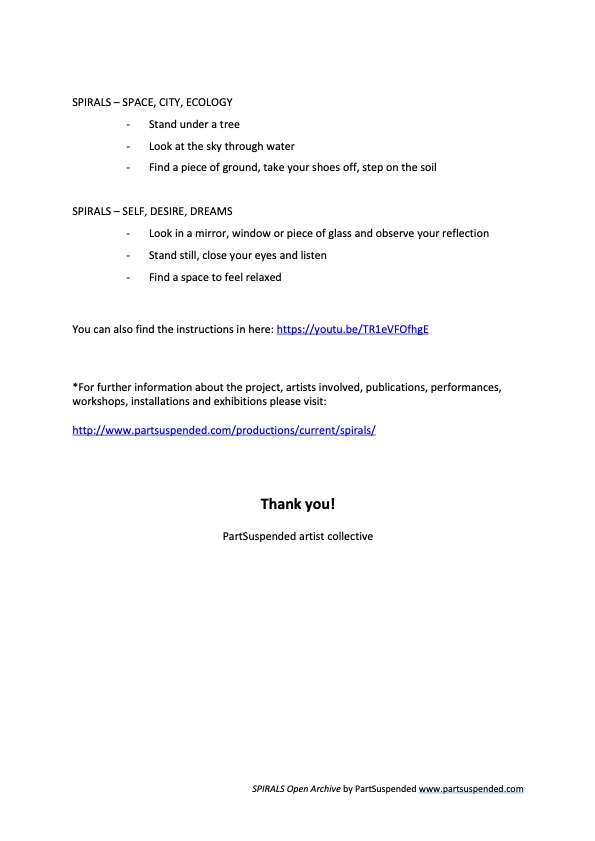
When considering which prompts were the most effective, it’s important to remind ourselves of the context in which the SOA took place. The ideas for this project emerged during and just after Covid-19 when we had all been subject to restrictions. We wanted our prompts to provide opportunity to meet and share, to resist isolation, to offer stimulation, to give permission and legitimacy.
The first sharing of our SOA provided the PartSuspended collective with an imaginative way of bringing together participants from different cultural and artistic backgrounds. It was a way of opening a creative dialogue and inspiring our participants to engage with actions that take place locally and share these with others, creating lines of communication that extend beyond geographical borders.
The twenty artists we invited responded very positively to the suggestions we offered and the sharing platform. The variety of responses we received evidenced the need the invited artists had to reflect on their lives at this difficult time. The theme of the spiral, the specificity of the actual instructions and the sense of being part of a project and a community of artists, facilitated moments of introspection, making and sharing.
Artists’ Responses to SPIRALS Open Archive
One of the more simple and specific instructions: ‘Find a piece of ground, take your shoes off, step on the soil – Stand still, close your eyes and listen’ gave permission for a participant to be still and reflect. It gave legitimacy to that activity. Simon Persighetti of Small Acts responded and created the piece Future Dig which not only implicates the listener and draws them into his struggle to articulate, but takes them to a specific location and makes them reflect on what it means to be in that place.
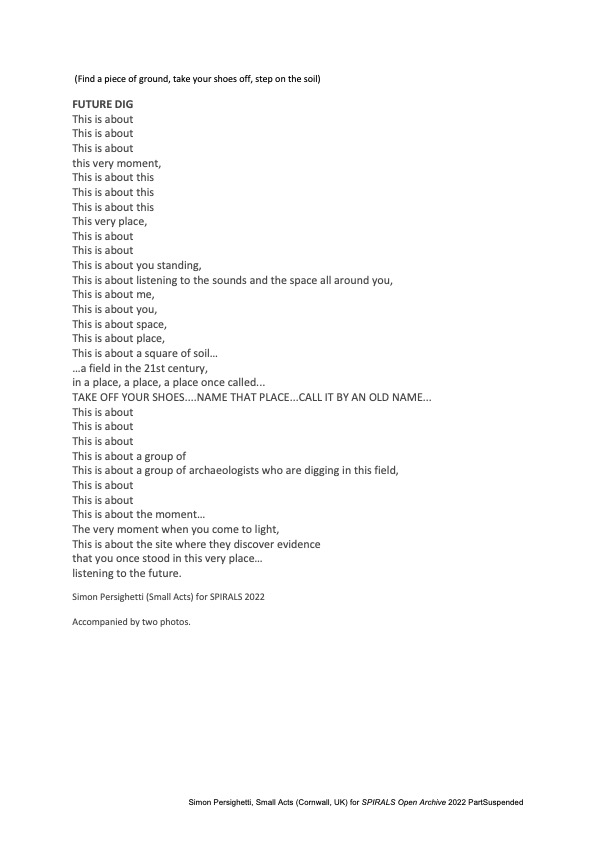
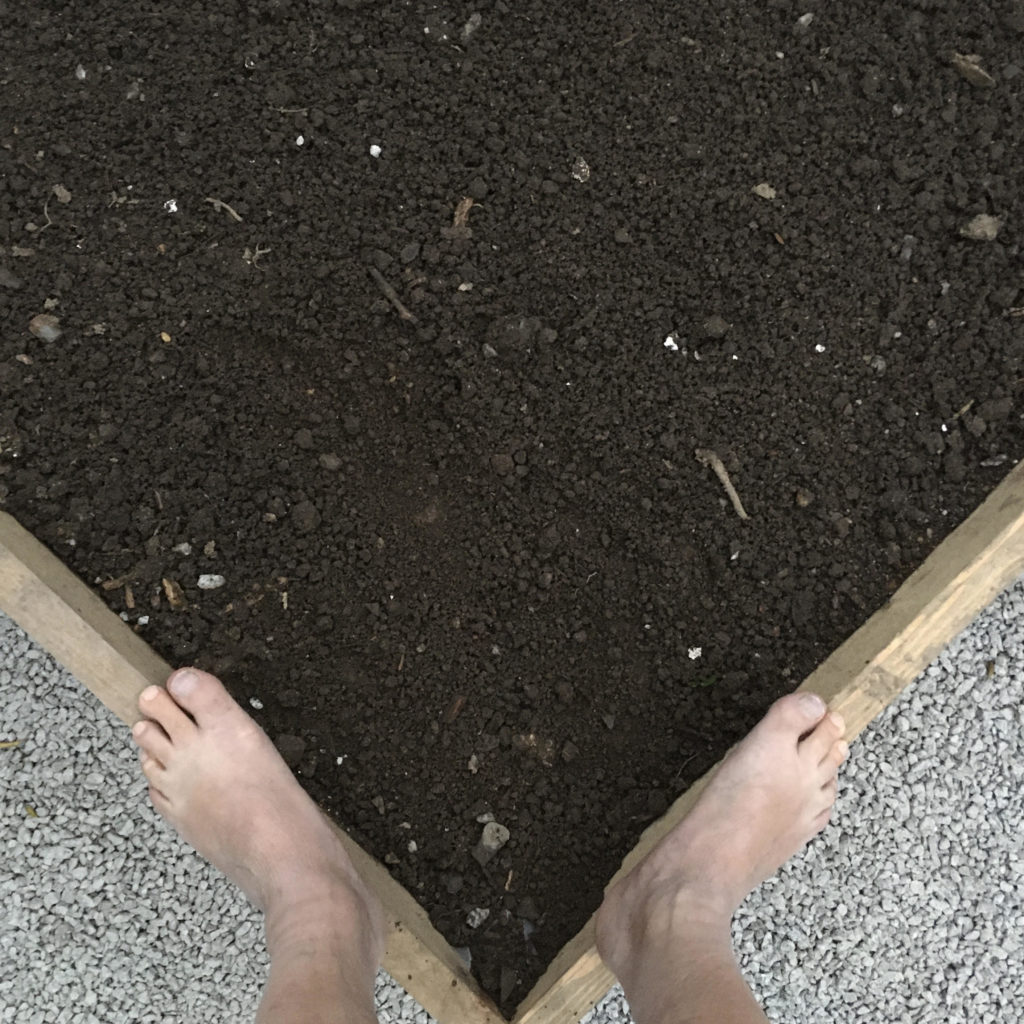
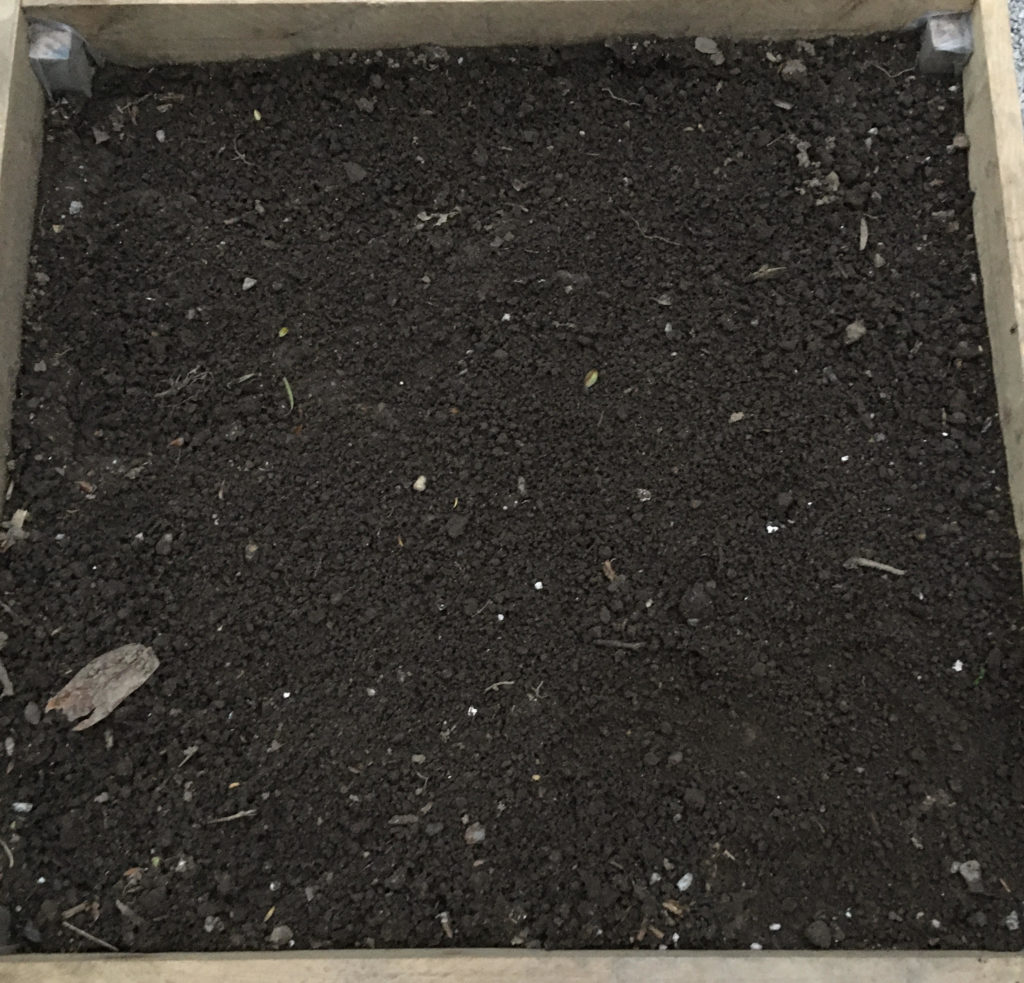
In a similar way Ruth Asidi was inspired by the prompts to ‘Walk in spirals, repeat a phrase that comes to mind’, to ‘Stand under a tree’ and ‘Find a space to feel relaxed’. Her contribution to the archive combines an embodied response to the notion of spirals with a linguistic exploration, bringing the two together around a rhythmic drummed spine to create a piece where Ruth is in her own words, ‘playing with the form of spirals as an ongoing process of cycles, becoming and transformation’. She further explains:
In this art-piece, the spiral represents the ongoing movement and force of life that I experience as change, transformational and cyclical in my female body.
Sally Pomme Clayton drew on her experience as a writer and pioneering storyteller and added the possibility of depth and new perspectives when she gave her personal response to our theme:
A spiral for me is: Hope and mystery. Returning and yet not returning. Going deeper. Being able to come back, but differently. A spiral changes perspectives.
She eloquently described a sense of sharing and permission and a wish to continue the exploration:
Sharing and making work inspired by spirals has been very enriching. Permission to be daring in a group of diverse creatives, who listen and share together, and being led on unexpected journeys. More please!
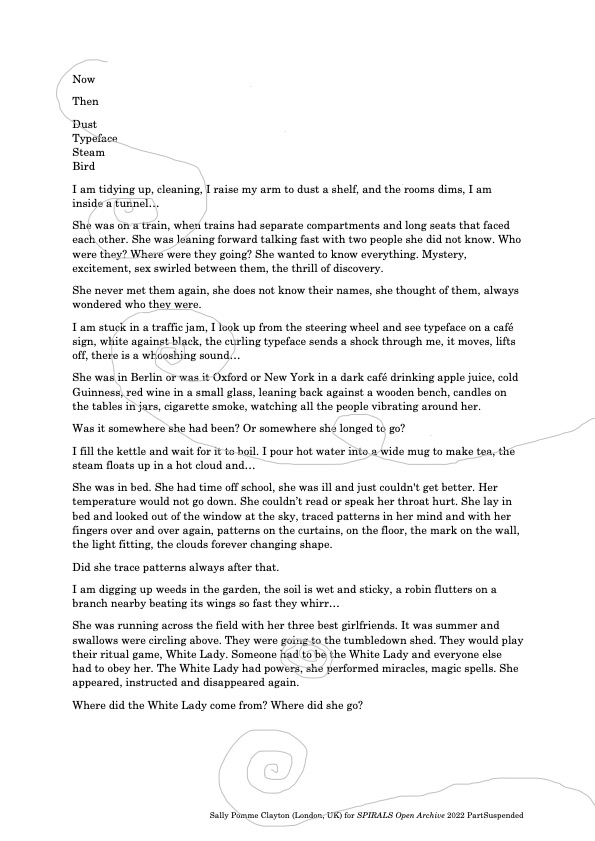
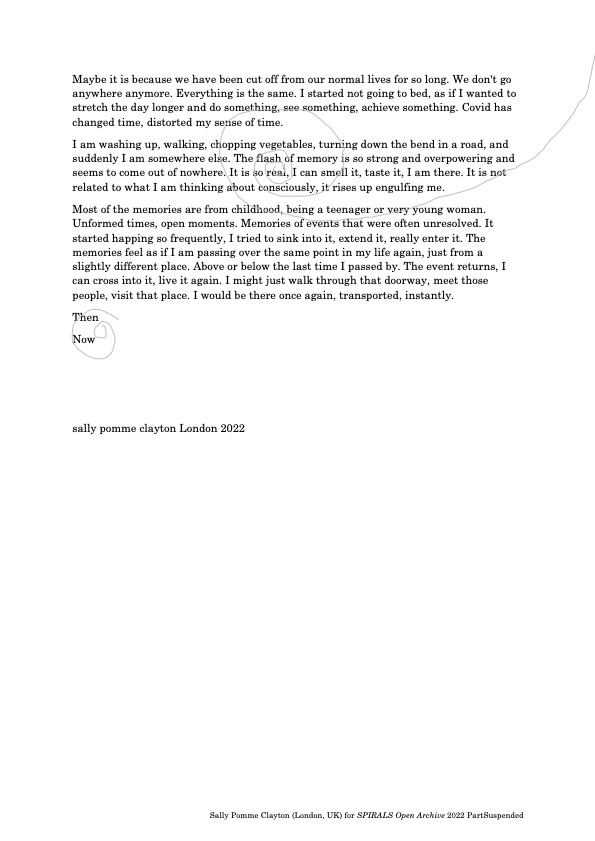
Suparna Banerjee’s video work ‘Spirals: My Last Death’ (Pune, India 2022) was created after having productive and stimulating discussions with the artist. The powerful imagery of the poetry was embodied and performed to camera. The spiral became a journey of self-exploration for the artist. As Suparna explains:
The spiral imagery is deeply intertwined with my existential thoughts and the position of women in the society in which I was raised. The spiral represents the rhythm of the tala (in the form of a circle) in which I dance or could be even my own heartbeats, which keep me going and moving. I have portrayed the death imagery as a spiral in my piece. When I first wrote “My Last Death,” a friend commented that she could feel the influence of John Donne’s line, ‘And, death shall be no more; Death, thou shalt die’. Although I had never read this poem before, I was very elated and soon started musing on the line. Later, I realised that, like Donne, I had personified Death, who had appeared in front of me to take trials and tribulations and undermine my beliefs and confidence. So, the motif of the spiral is deeply etched into my psyche, my personal thoughts and self-determination. I began writing this poem when people, systems and customs were conspiring against me, as if to push me out of their sphere. I stepped out of my comfort zone and embarked on a journey of self-discovery. Hari and I had nice and long conversations about the poem, and she expressed her admiration for the powerful imagery it conveys, especially ‘Now over the ages I tread unafraid/ And find no Death around me annihilate’. When Hari was reflecting on the poem, I could feel as if she could read my struggles and adversities; my deeper thoughts got connected to her heart. How beautiful that is! During the lockdown phase, when I was creating the screendance using the piece, my creativity was put into the orbit of Spirals with other artistic creations. So, my introspective thoughts, my self-journey in the realm of the unknown and my association with the artist fraternity are all central to the idea of Spirals.
Whilst for the process of sharing and meeting the other artists via an online platform, Suparna says:
From initial conversations to choreographing, from the process of recording the dance (using my home space, the balcony and the spiral patio downstairs) to interactions online, all were a fantastic learning experience. People were very friendly and engaging, and I thought it was quite reciprocal. The exchanges offered me an alternative lens to view how others have perceived my piece!
Niya B linked the spiral to her creative process and to specific incidents where, over a 20 year period, she crossed geographical borders, found herself immersed in Nature and used the spiral form to create two generative and inspiring interventions in the landscape. As Niya describes:
I see the spiral as constant movement of my creative energy, reflecting my relationship with the world:
-going inwards in order to understand things and create work.
-going outwards in order to communicate, to be in touch with my environment, to express the work and gather feedback.
This process has no beginning and no end, no specific length and no specific order.
The first time that I crossed the borders of the country I was born in (Greece), I stayed in a rural place in Northern Germany. I was interested in permaculture and while staying there, I built a spiral with stones on the ground and planted herbs inside.
Incidentally, 20 years later, when responding to the Spirals Open Archive, I was again temporarily out of the country I live in (UK), at the artist residency of Crazinist artist in Kumasi, Ghana (pIAR) [6]. During that month and among other things, I was fascinated by the seeds of the papaya fruit which is abundant in Ghana. My response to the project was a performative act of digging a spiral trench in the ground and placing the seeds inside.
I only recently realised the connection between the 2 spirals and how they manifest when I am crossing national, cultural and geographic borders.
Colin Cruise responded to our prompts by taking a series of photographs of a spiral shell. These photographs inspired a series of questions and the responses to these questions form the basis of a piece of writing which moves from close observation of the shell to a particular intimacy that allows the writer to imagine entering its structure.
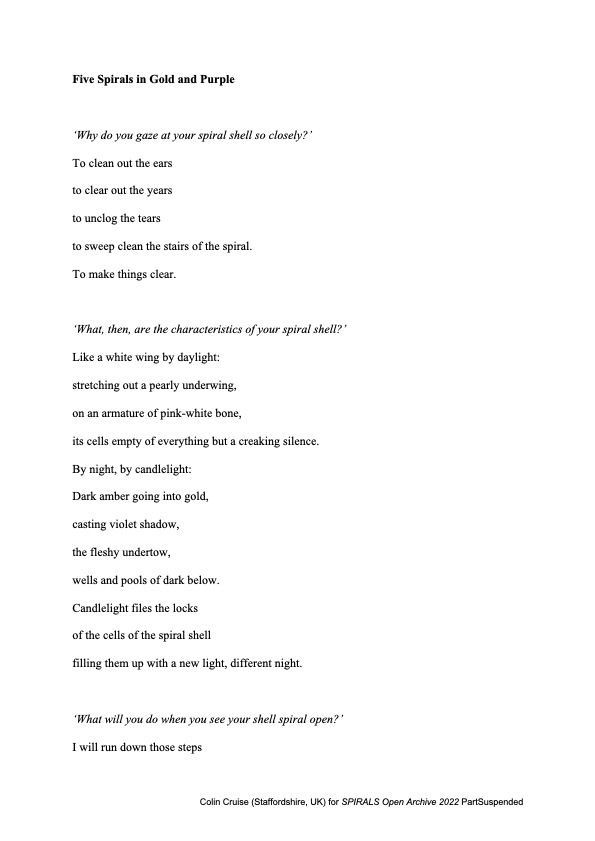
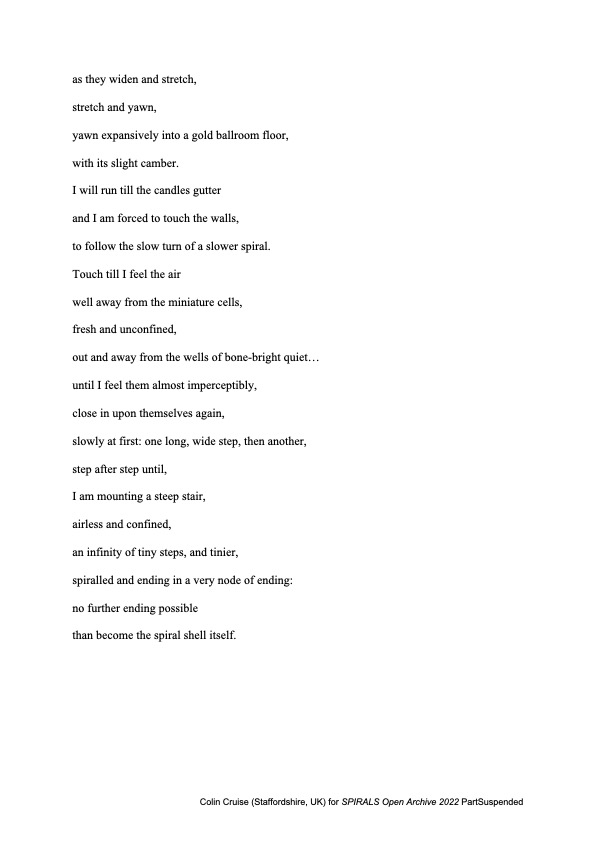
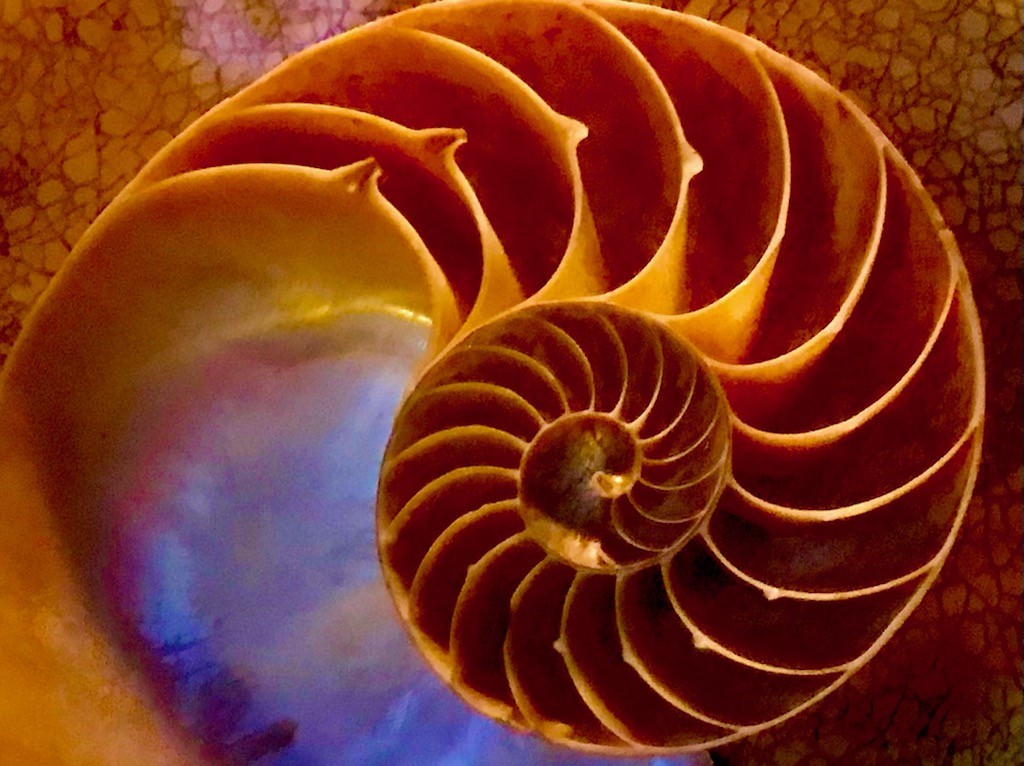
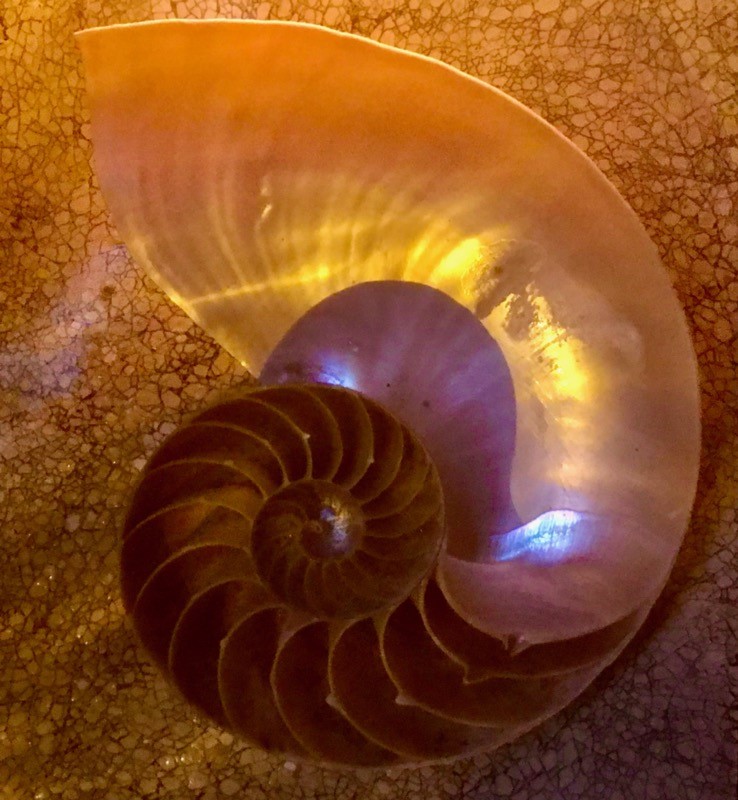
Colin expressed a wish to take the work he developed for the archive further and acknowledged his sense of collaboration when he spoke of ‘the larger vision of the group’.
There is so much to say about spirals, so many different ways of opening up an enquiry around them […..] I was hoping to develop my own piece into a short poetry-based film (with an expanded, more complex poem on being locked in a spiral chamber) with accompanying animated images. I might still do so. If the project has a next stage, it would be interesting to see how this film idea might fit into the larger vision of the group.
For John London ‘the prompts gave enough guidance and, at the same time, freedom to explore different avenues’ and he created collages that combine found images and text in a series of comments on the circularity of nostalgia, social encounters and our desires, and one page of a theatre dialogue. London points out the importance of personal touch and although he found it fun to meet people online, he observes: ‘Who can substitute the chat over a drink, even if that drink is coffee?’. John suggests:
Let the spiral be an eternal circle of creation. Boxes, pockets, cupboards – all to open for the secrets inside.
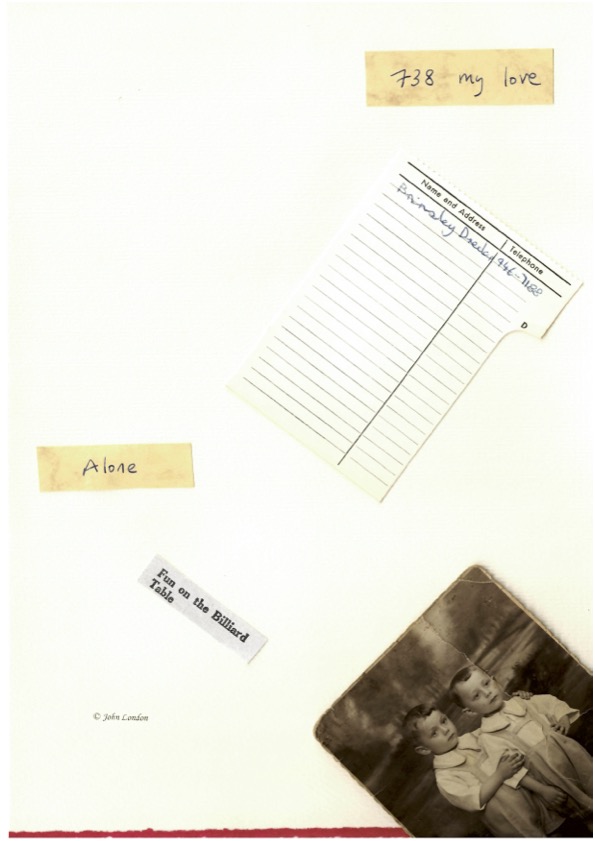
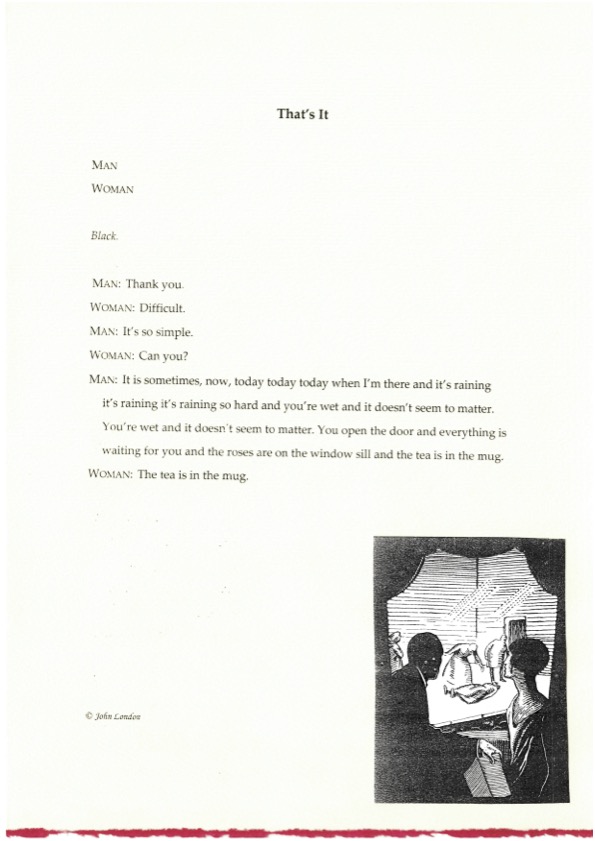
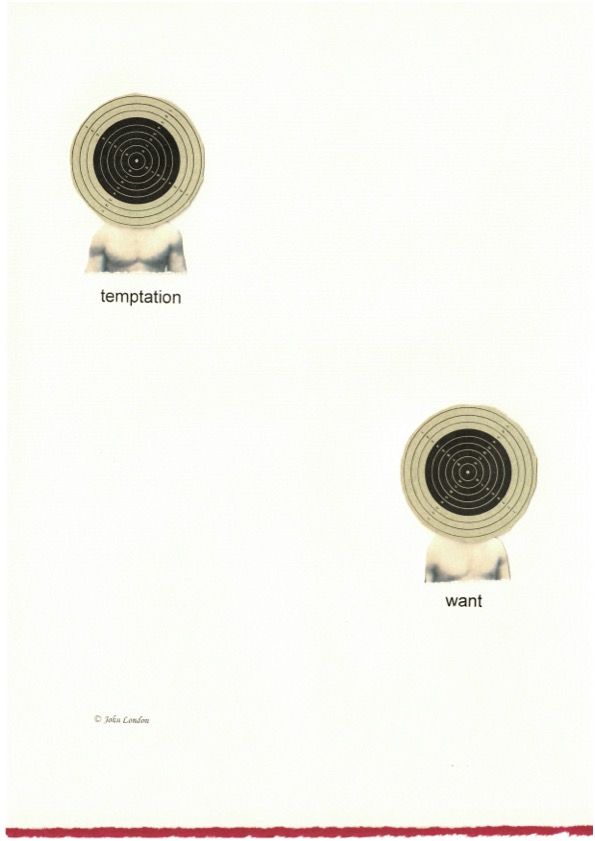
Lynn Lu also focussed on the presence of the spiral in nature and in particular its connection with sound, sending us an annotated detailed drawing of the inner ear. Her accompanying text describing the cochlea, its function and its relationship with other phenomena like whispering walls and infrasound, is clear and informative and when spoken by Lynn the text transforms and becomes poetic. She says:
I was thinking about the shape of the cochlea in the inner ear, and the way infrasound (frequencies below audible range) waves travel all to the apex of the spiral. The energy in the sound waves accumulates against the edge of the chamber in a “whispering gallery” effect, where low-frequency sounds “creeping” along curved walls can be heard anywhere along the walls of the space. Infrasound, characterised by its ability to get around physical obstacles with little dissipation, is used by certain animals to navigate and to communicate over great distances.
Animals that perceive infrasonic waves caused by natural phenomena such as tsunamis, etc. have been reported to flee well before disasters strike. The power and stealth of infrasound’s ability to “creep” along curved walls, around obstacles, and certainly across borders, is an idea I wish to explore further.
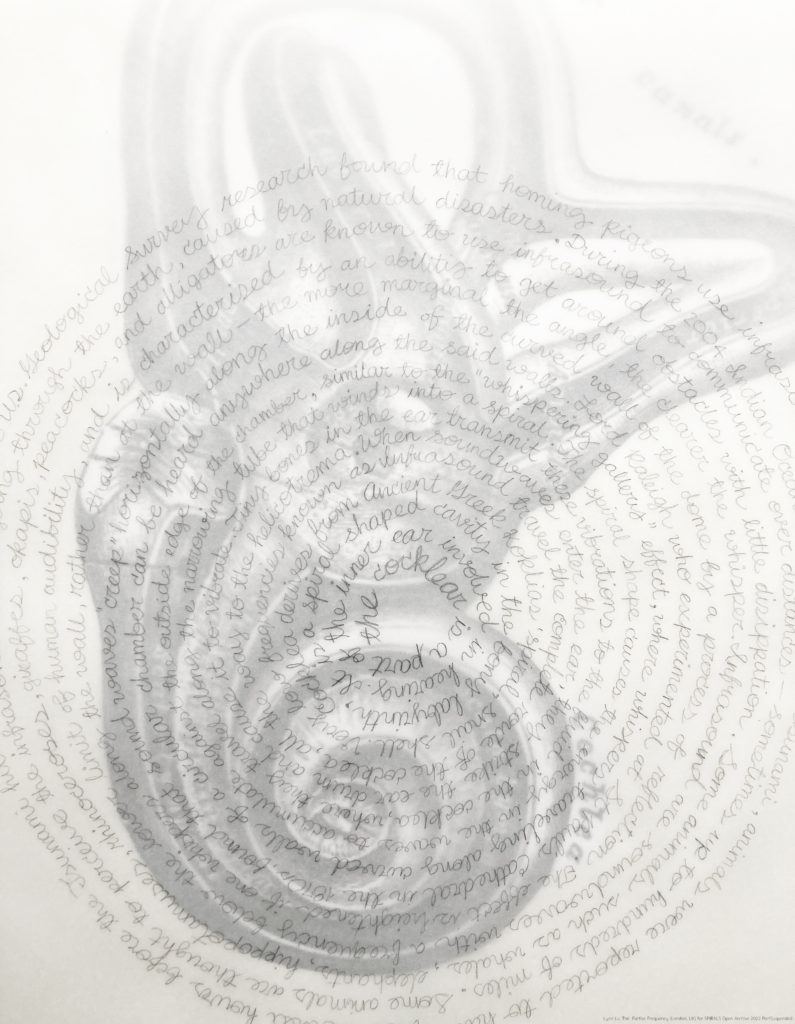
[note: the cochlea illustration is from Gray’s Anatomy, Plate 921]
Kostis Ntemos, reflecting on the process of meeting other ‘spirallists’, found ‘both the Communal and the Ritualistic’ aspect of the project and the meeting ‘a heartwarming experience’ and he explained that ‘the prompts were a considerable stimulus for me. The Minuscule to Cosmic scale balancing, the word Spirals itself evokes, worked for me immediately. He was also intrigued by what might develop and made the following observations about our theme:
A Spiral is an ever-evolving form/beyond form. Arms twirling and outstretching the canopies of space, from the mundane to the everlasting.
Spirals definitely has transcendental qualities in its promise. Would love to see how it translates on the next step of its existence.
Kostis’s astrophotograph of the Andromeda galaxy was sent to the PartSuspended collective recently – testifying the ongoing inspirational journey of SPIRALS – alongside Kostis’s notes:
It was shot over the course of 6 nights from my balcony. It is a spiral galaxy in structure, much like our own and it is moving towards us in a collision course that will have us merge with her in a few billion years. Such is the fate of spirals I thought. To gravitate towards one another.
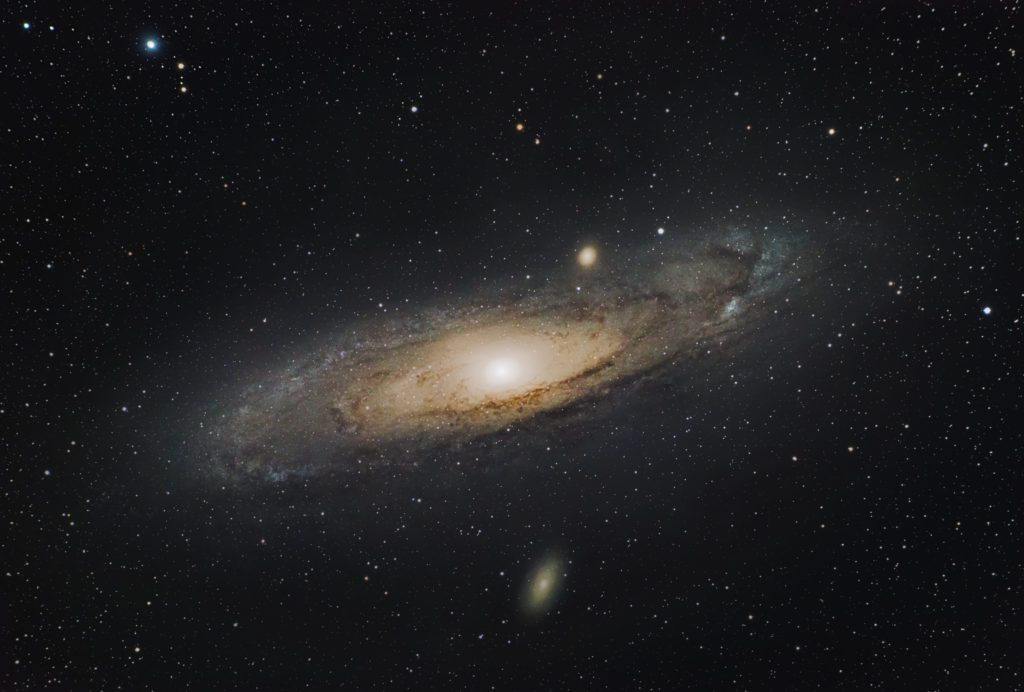
Dimitra Adamopoulou takes us back to nature in her response to the spiral, making a visceral comment on the toxicity of contemporary life and our relationship with local and global ecosystems. As Dimitra vividly explains:
Ιn my work that I sent you, the spiral reminds me of a snake around my neck like the serpent around the proverbial tree, as well as the spiraling way of thinking and breathing.
[…] the spiral became a noose and a snake that I created, that suffocated me through my own will. So the poem and video is a way (an incantation maybe) to create a different reality for me, to destruct or self-destruct by becoming the serpent, and then create a new universe from that, because nothing ever ends, only transforms. That’s all.
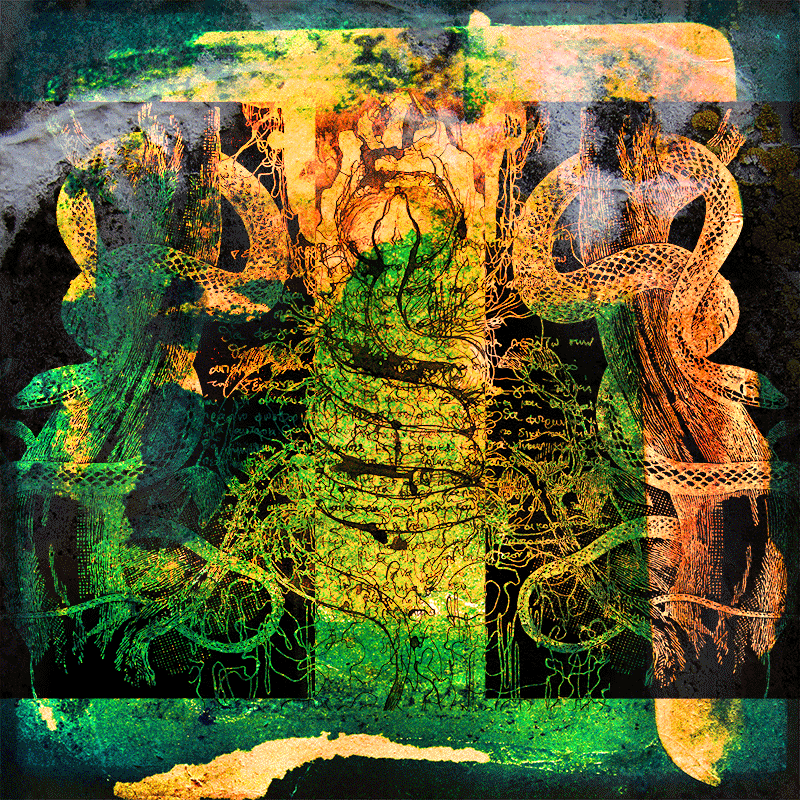
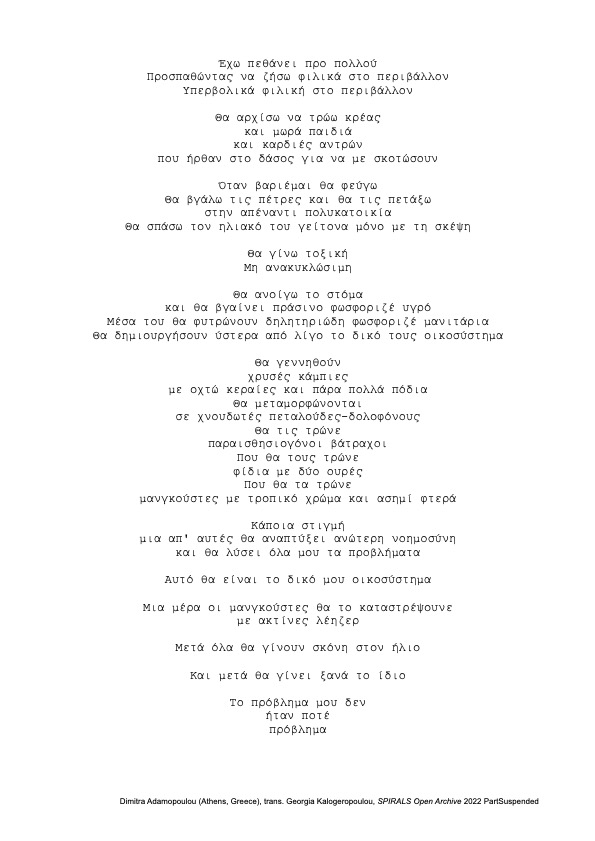
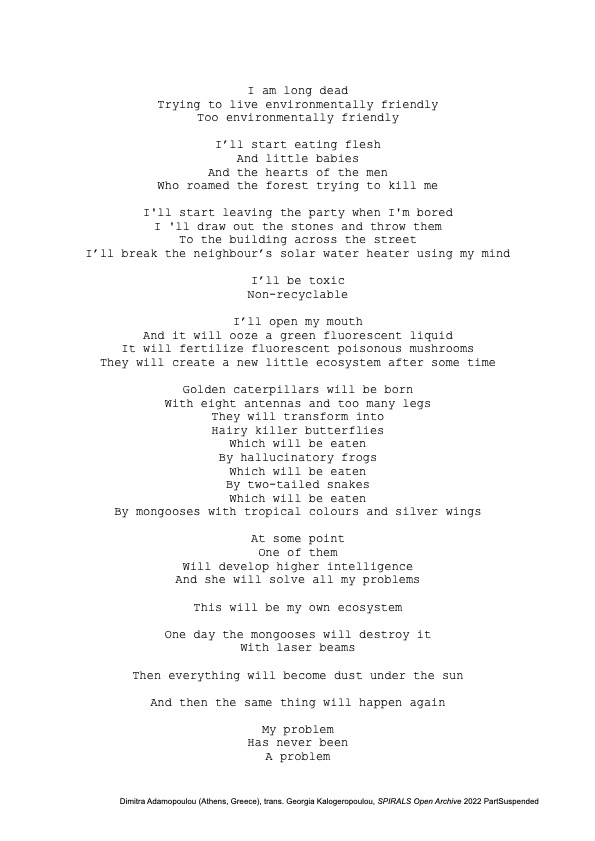
Nikos Kabasele’s response evidences a very personal reaction to the spiral, a moment when it gives access and provides a metaphor that can express how strong forces can act on the human body and psyche. Nikos uses two forms of the spiral in a visual image where he shows spirals consuming a figure both internally and externally. He describes his work as:
a reflection about a certain type of romantic relationships: The one that reveals hidden and darker aspects of ourselves. Often leading to very uncomfortable situations. Although somewhat terrifying, this path can be essential to an individual’s spiritual development. The never-ending cycle of introspection becoming a forever-expanding universe. A spiral, moving in two directions.
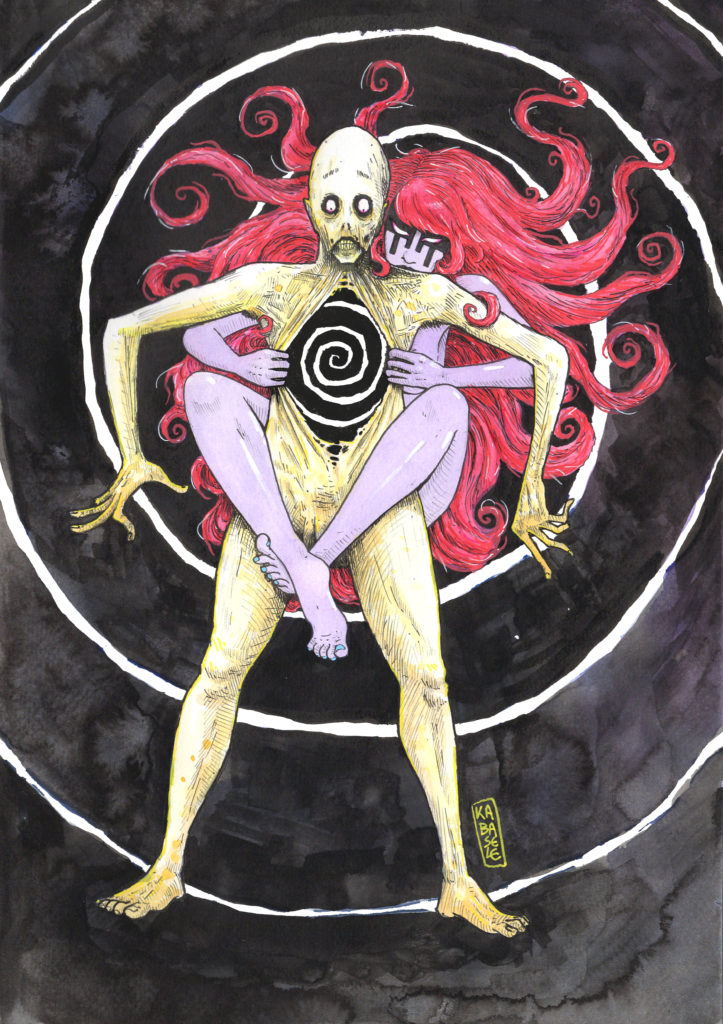
Nikos Kabasele (Alexandroupoli, Greece) for SPIRALS Open Archive 2022 PartSuspended
Krishna Goswami leads us back into the heart of lockdown and close to some of the emotions we all experienced at that time by sharing some of the childhood images that consoled her in her isolation and reminded her of her family’s history of making art. As Krishna says:
Our earth, sun, galaxy, and this whole universe is spiraling around and at the same time expanding forever. Home is part of this spiral! It is the place where I find love, strength, respect, education and the discipline to gain social, economic and psychological security. It has given me the space and training to emerge stronger and expand my wings. Home is that sense of freedom where I can always come back in darker days to seek solace and light!
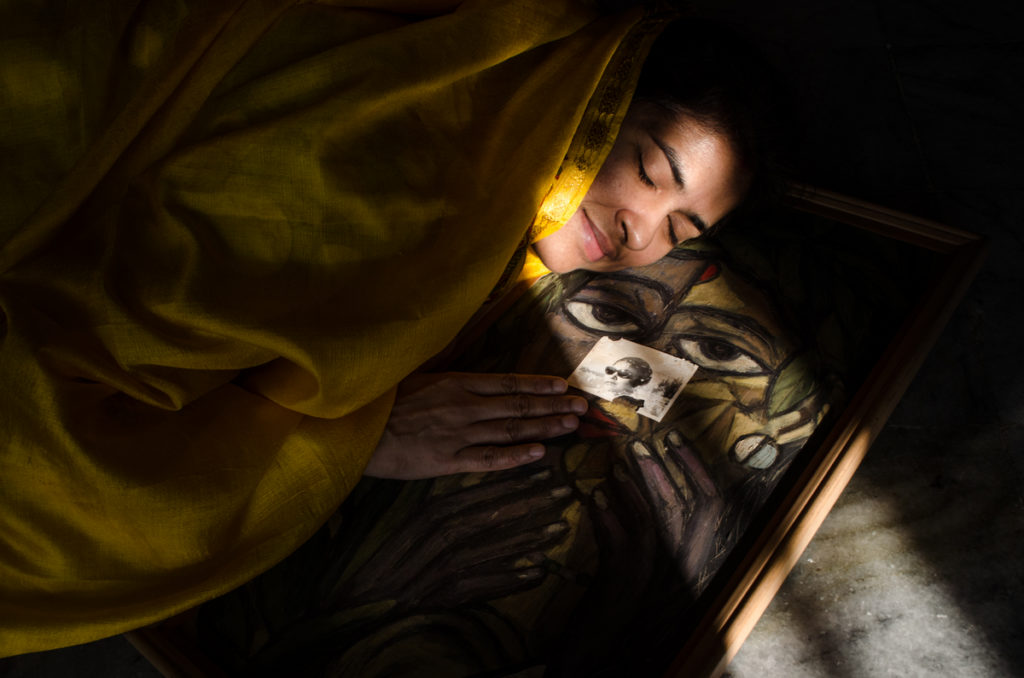
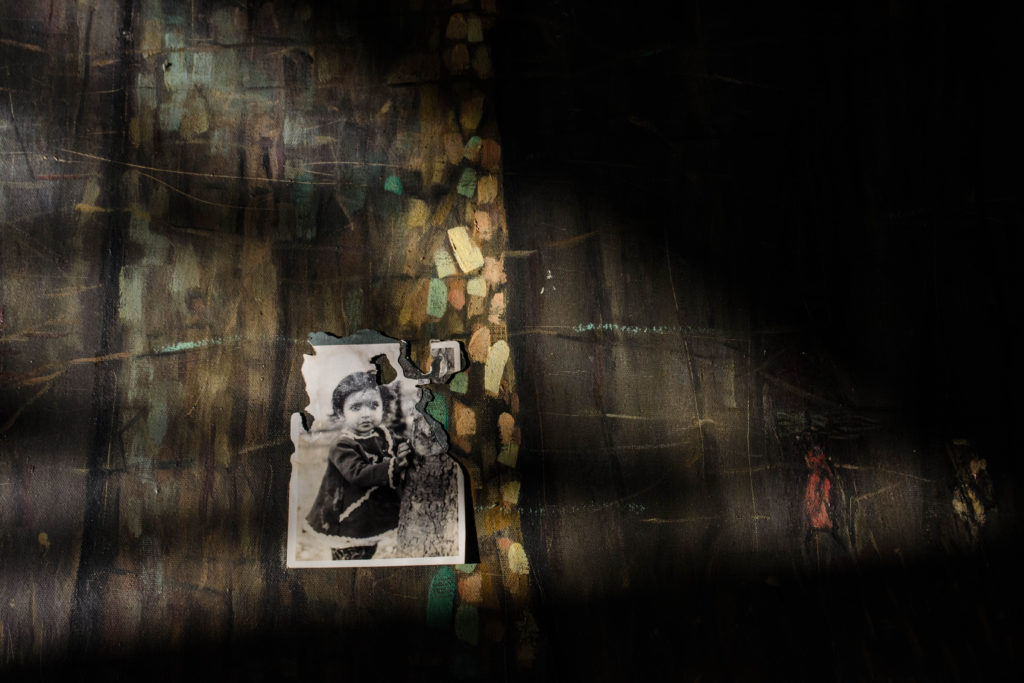
Endless Spirals: Some thoughts
We have already drawn attention to the context in which we were operating. Brexit and Covid-19 imposed new borders and placed new restrictions on our lives. The SPIRALS Open Archive could be seen, in this context, as an act of resistance, an act of care, an insistence on a global perspective.
Even if solo work is produced, artists are never making art in isolation. We believe that we are always pursuing our creative journeys alongside others who provide the cross-fertilisation across disciplines, geographical borders and concepts that is essential for our work to flourish and grow. In this way, setting up an environment that gives permission and provides support and an invitation to create could be seen as subversive.
There are also ways in which our activities subvert the use of online communication. By using online platforms to make work and share it, we were creating an active and participatory artistic community within this often sterile environment. We are also planning to continue this subversion, by launching a flexible, open, ongoing archival process in the form of an online repository.
On another level the SOA has certainly added to the ‘vision’ of the ongoing SPIRALS project by introducing new interpretations and approaches and by extending the possibility of new collaborations. The participants’ many and varied explorations of the spiral as a theme broadened our perspective. It was observable (in the showings) that when represented in language, the spiral often became a reason to repeat, revisit and re-emphasize, prompting investigations into rhythm and rhyme and circular narratives. And as a prompt to physical action, the spiral was often represented and explored in walking practices, movement and gestures that reveal the rhythms of the body and the body’s relationship with organic forms.
Through the SOA prompts, the symbol of a spiral was translated into art forms that embrace performance, drawing, photography and audiovisual work, celebrating different forms of expression. In the creative responses our contributors explored their personal engagement with the theme, their personal memories and desires and the connection between the local and the global. Some of these interpretations might have been anticipated, but others could not, they were unexpected and surprising and created new and original ways of thinking about our theme.
The spiral evolves becoming larger, opening and expanding outwards. Our SOA will keep holding an open space for a community of ‘spirallists’ who would like to share work, thoughts and practices, resisting isolation and dominant narratives. The SPIRALS Open Archive emphasises the importance of crossing borders, appreciates multivocal artistic expressions and celebrates acts of being together.
We invite anyone who is interested in joining SPIRALS Open Archive (SOA) and being part of the project to contact us at
[email protected] – [email protected] | @PartSuspended_Hari_Marini
Notes
[1] – For further information about SPIRALS project – performances, publications, workshops, installations, exhibitions – please visit: http://www.partsuspended.com/productions/current/spirals/
[2] – SPIRALS by PartSuspended (Part A): Performance Writing | Mapping the Body
SPIRALS by PartSuspended (Part B): From one Poetic Form to the Other | Hearing Colours
SPIRALS by PartSuspended (Part C): Poetry in Action | Drifting in the City
[3] – SPIRALS by PartSuspended: Artist Talk and Showings – Performance presentation
[5] – The essays focussed on ‘Spiral as metaphor’ by Barbara Bridger, ‘Desire and rage: A female spiral’ by Georgia Kalogeropoulou, A woman’s spiral in cityscape’ by Hari Marini, and ‘The Female Poet Creates Spirals: A Question of Nomadism?’ by Noelia Diaz-Vicedo
[6] – Niya’s An end and a beginning was filmed at perfocraZe International Artist Residency (pIAR) in Kumasi, Ghana, where Niya was a resident artist in January 2022. pIAR is in danger at the moment due to the anti-LGBTQ+ bill that has been proposed in Ghana. Please follow the link to donate: https://www.crazinistartist.com/piar-artist-in-residency/
Biographies
PartSuspended artist collective works in a variety of art forms and disciplines. In 2006, Hari Marini co-founded PartSuspended as a dynamic platform on which to foster performances, live art, installations, writing and collaborations with artists from a variety of disciplines. The collective creates artistic work starting from personal experiences, everyday life, social space and architecture. They draw on contemporary life for their material: questions, pleasure, anger, fractures, contradictions; they explore these with the audience. PartSuspended has presented their work to a variety of venues such as DAN24, Spatial Culture Festival, BAZA (Novi Sad); Prague Quadrennial of Performance Design and Space (Prague); Tate Modern | Tate Exchange (London); BIOS Tesla; National Theatre of Greece – Experimental Stage; Camden People’s Theatre (London); Peopling the Palace(s) Festival QMUL (London); Arcola Theatre (London); Southwark Playhouse (London); Emergency 2013 (Manchester); Siobhan Davies Dance Studio; ]performance space[; ZealousX (Bargehouse, Oxo Tower Wharf); Railway Carriage Theatre (Athens); DVM Theatre (London); NoGrayInMyDay Gallery (London); You & Your Work (Bristol). @PartSuspended_Hari_Marini
Dr Barbara Bridger is a core member of PartSuspended artis collective. She taught Theatre and Performance Writing at Dartington College of Arts between 1990 and 2010 and is currently an independent writer, director and dramaturg. Her prose, poetry, scripts and critical writing have been widely published, performed and screened. She was Prose Writer of the Year 2002 (Writers Inc.) and has been short-listed for several other awards including Asham and Raymond Carver. At Dartington, Barbara Bridger helped to develop Scripted Media. This explored experimental approaches to script and scripting and her research also focuses on women’s writing and inclusive dramaturgical processes.
Dr Sarahleigh Castelyn is a core member of PartSuspended artis collective. She is a performer, choreographer, and researcher: a dance nerd. She is a Reader/Associate Professor in Performing Arts in the School of Arts and Creative Industries at the University of East London (UK). Her research focuses on race, gender, sexuality, and nation in apartheid and post-apartheid South Africa, the politics of hybridity, and the use of practice as a research methodology.She has performed in and choreographed performance works, for example at JOMBA! Contemporary Dance Festival (South Africa) and The Playhouse (South Africa). She serves on a number of editorial and organisation boards, such as The South African Dance Journal and HOTFOOT. She has published research on performance and South Africa, for instance in Viral Dramaturgies (2018) and Narratives in Black British Dance (2018), and in journals such as The African Performance Review, Dance Theatre Journal, Animated, African Performance Review, and The South African Theatre Journal.
Dr Noèlia Diaz-Vicedo is a core member of PartSuspended artis collective. She is a Lecturer of Comparative Literature at the Department of Catalan Language and Culture at the University of Balearic Islands, Spain. She is also a poet and translator. She has published her poetry in various magazines and anthologies in Spain and USA. Her collection of poems ‘Bloody Roots/Arrels Sagnants’ in bilingual edition (Catalan-English) is published by Francis Boutle Publishers, 2017. She has performed her poetry around UK and Spain. She has completed her thesis at Queen Mary University of London (QMUL) on the poetry of Maria-Mercè Marçal published by MHRA (2014). She combines teaching with research on contemporary women’s poetry and gender studies at UIB. She is a Fellow at the CCWW (Institute of Modern Languages, University of London), a Fellow at the Centre for Catalan Studies and the Centre for Poetry at QMUL.
Georgia Kalogeropoulou is a core member of PartSuspended artist collective. She is an Athens based researcher in philosophy, musician, visual artist and performer. Her academic interests are centered around Psychoanalysis and the Philosophy of time. She is a multi- instrumentalist (playing piano, synthesizers, electric guitar, saxophone, trumpet and traditional Greek instruments), and she performs regularly with numerous bands and artists in London and in Greece. She also makes paintings and comic books and she loves to explore the expressive potential of colour and light. Her research in philosophy draws on her experience as an artist; she explores the notion of time in the crossroads between philosophy and psychoanalysis, and she aims to understand the aesthetic experience as an example of any individuating process.
Dr Hari Marini is a performance maker, researcher, educator, and founding member of PartSuspended artist collective. She is Associate Professor of Performance and Intermediality within the Department of Audio and Visual Arts at Ionian University, and Artistic Director of PartSuspended artist collective who fosters performances, live art, installations, writing and collaborations with artists from a variety of disciplines. Her research focuses on social and material contexts and conditions of performance and their social and political effects. Hari’s research outputs have been published in leading academic journals, such as European Journal of Women’s Studies, Contemporary Theatre Review, Performance Research, Journal of Greek Media and Culture, and in the edited book Dramatic Architectures: Theatre and Performing Arts in Motion (CEAA/ESAP). Hari’s artistic practice, writing and practice-based research focus on poetics of spaces, performative architecture and women’s writing. Through her work with PartSuspended, she expands her practice-based methodologies, advancing the interdisciplinary approach to her work. She has established collaborations with sociologists, architects, dancers, visual artists, photographers and writers. Her artistic work has been presented to a variety of venues and festivals in the UK, Spain, Greece, Serbia, Czech Republic. Her creative writing and video-work have been published to journals and poetry collections such as Tears in the Fence, Interim: A Journal of Poetry & Poetics, performingborders, and her bilingual book (Greek-English) entitled 28 Διαδρομές της/28 Paths of Her was published by AΚΑΚΙΑ Publications. Hari has previously worked as Associate Lecturer at Queen Mary University of London and has been a guest lecturer and reviewer in a variety of institutions, such as University of Essex, Drexel University, Pratt School, Theatre of Changes.
Contributing Artists
Dimitra Adamopoulou paints and makes comics as long as she can remember herself. She studied painting at the Athens School of fine Arts and comics & illustration at Ornerakis School of Applied Arts. She has also participated in various exhibitions with her comics, illustrations and paintings. She teaches art at “To Spirto” art lab, and at Ornerakis School of Applied Arts.
Ruth Asidi is a multidisciplinary dance artist based in North-West England. Her practice is process driven and co-creational with a focus on self-discovery, animism and the relations between the inner and outer landscapes of the body. In 2014, Ruth graduated from the University of East London with a BA in Dance, an experience which gave her a broad anthropological viewpoint of dance styles deriving from African, Asian and contemporary western influences. In 2018, Ruth completed an MA in Somatic Movement Education, the field of study interested in the Soma, the living body and its experiencing self. It is through this inquisitive and therapeutic way of understanding the body that Ruth develops her personal practice and works with others, perceiving every ‘thing’ to be alive, communicating and able to co-create. Ruth uses movement and drumming as a means for storytelling, exploration and research.
Niya B works at the intersections of visual art and performance, exploring ecology, posthumanism and (trans)gender politics. She seeks to establish intimacy with her audience, creating a meditative space of vulnerability, affect and interdependence. Niya has exhibited and performed at Tate Britain (London), CCA (Glasgow), Site Gallery (Sheffield), NEoN festival (Dundee) & 5th Moscow Biennale among others. She has been supported by Jerwood Arts, Arts Council England, the British Council and the Cultural Institute Leeds. In 2022, she became a resident artist at BOM Immersive Lab. Niya is a PhD candidate at Kingston University, School of Art, where she investigates the intersections of ecology and gendered embodiments across human and non-human subjectivities through digital technologies.
Suparna Banerjee received her PhD in Dance Studies from the University of Roehampton, UK. She studied Bharatanatyam dance and Indian Classical music and has received numerous awards and grants for her works. Her choreographic works illustrate the intersection of theory and practice. She was invited to teach at Iowa State University and Pennsylvania State University, United States, and contributed to the development of India’s undergraduate dance curriculum at a liberal arts college. Her choreographies were showcased in numerous nations, including Germany, France, Belgium, Switzerland, the United States, and the United Kingdom. She has published her research in peer-reviewed journals and a book.
Sally Pomme Clayton, please call her Pomme! has been a pioneering writer and spoken-word artist for more than 30 years. She is author of 16 children’s books and associate artist at Omnibus Theatre. She creates, writes and performs stories for everyone, from: The London Gypsy Orchestra to The London Philharmonic Orchestra; Chelsea Physic Garden to West Norwood Cemetery; Rhythm Tree Festival, Isle of Wight to Edinburgh Literature Festival; Cambridge Junction to Kings Place; Edinburgh Literature Festival; Bloomsbury Festival to Hakaya Festival, Jordan; Thames Festival to Dhaka Lit Fest. She has made many innovative and pioneering pieces of work that combine music, narrative and digital technology. Most recently ‘The Frog Princess Punked’ along with Georgia Kalogeropoulou and Dawn Rose a feisty feminist fairytale with girl punk band and live projections.
Colin Cruise is from Northern Ireland but lives in Staffordshire, England. He studied painting and printmaking in London before undertaking degrees in Victorian Studies and English Literature. He has published in several areas, chiefly in art and literary cultures, gay studies and the history of drawing. He retired from university teaching in 2018 and spends his time walking, taking photographs and writing.
Krishna Goswami works as an Assistant Teacher in a government sponsored higher secondary school in Kolkata, India. An avid learner, Goswami loves to tell stories through the visual medium of photography. The space and transition of time intrigues Goswami. The metaphorical rhythm of the chaos and silence of life get portrayed in the making of the images. She has been part of a number of national and international photo exhibitions. Goswami has been published in platforms like the erstwhile Yourshot National Geographic, 121clicks, sixfeet.photography and Better Photography magazine.
Nikos Kabasele was born in Athens in 1986 and grew up in Alexandroupolis. He was painting from a very young age. He graduated from the Athens School of Fine Arts and from the École Européenne Supérieure de l’Image (Master BD,Angoulême). He has participated in various comics festivals and collective exhibitions as an artist. He has also had personal exhibitions of his paintings. His work has been published by publishers such as: Hestia publishings, Enati Diastasi, ADDART, Paratiritis tis Thrakis and by the Ethnological Museum of Thrace. He has collaborated with magazines such as: ANTI, Mple Komitis and Comic Cultura. His hobbies are: miniature painting, boardgames and mixed martial arts. He lives and works in Alexandroupolis, as an art teacher in SOS Children’s Village of Thrace and as a freelance artist.
John London is Professor of Hispanic Studies and Director of the Centre for Catalan Studies at Queen Mary University of London. His books include Reception and Renewal in Modern Spanish Theatre (1997), Contextos de Joan Brossa (2010) and, as editor, Contemporary Catalan Theatre (1996, with David George), Theatre under the Nazis (2000), and One Hundred Years of Futurism (2017). He has translated plays from Catalan, Portuguese, Romanian, and Spanish by playwrights such as Sergi Belbel, Pedro Calderón de la Barca, Federico García Lorca, Andreea Valean, and Pedro Vicente. John’s own published and performed texts include You Know How These Things Are (1998), Right (1999), The New Europe (2000), and Nex (2005). He completed The COVID Trilogy with Chris Danowski, from which Another Time This Time was produced in 2022.
Lynn Lu (PhD, AFHEA) is a visual artist who lives and works between Singapore and London, and trained in USA, France, Japan, and Australia. Her research-led multidisciplinary practice emerges from her interests in context and site specificity, participation and collaboration, and the poetics of absurdity. Engaging vigorously with the present reality of all that is here-and-now, the meaning of her works often manifests in the resonant relationships created between herself and her audience. Lynn exhibits and performs worldwide. Selected venues include National Gallery Singapore (2022), SFMOMA (2021), Staatlichen Kunstsammlungen Dresden (2019), Science Gallery London (2017), Saatchi Gallery (2017), Palais de Tokyo (2015), The Barbican (2015), Perth Institute of Contemporary Arts (2013), Tate Modern (2010), Beijing 798 Art Zone (2009), and Singapore Art Museum (2007). Lynn is a Visiting Artist at London College of Communication, UAL, Associate Lecturer at Nanyang Academy of Fine Arts, and Associate Artist at ]performance s p a c e [.
Kostis Ntemos was born in Athens on the 2nd of January 1980. Through juvenile introversion and later nerdom he seeked to explore and explain how and why he was so attracted to fantasy and reverie. This corpus of dreamscapes led him to poetry and heavy metal for answers. He is currently preoccupied with astrophotography and medieval bookbinding.
Simon Persighetti is a member of Small Acts based in Cornwall, UK. working with people and places to create live participatory artworks and performances that invite audiences and participants to investigate their own relationships with the places in which they live, work and play. He is also a core member of Wrights & Sites, a group of performance-trained artists who produced international site-specific performances, walking projects, publications, and other artworks since 1997. Their latest Mis-Guide book, The Architect-Walker was published in 2018 by Triarchy Press, UK.